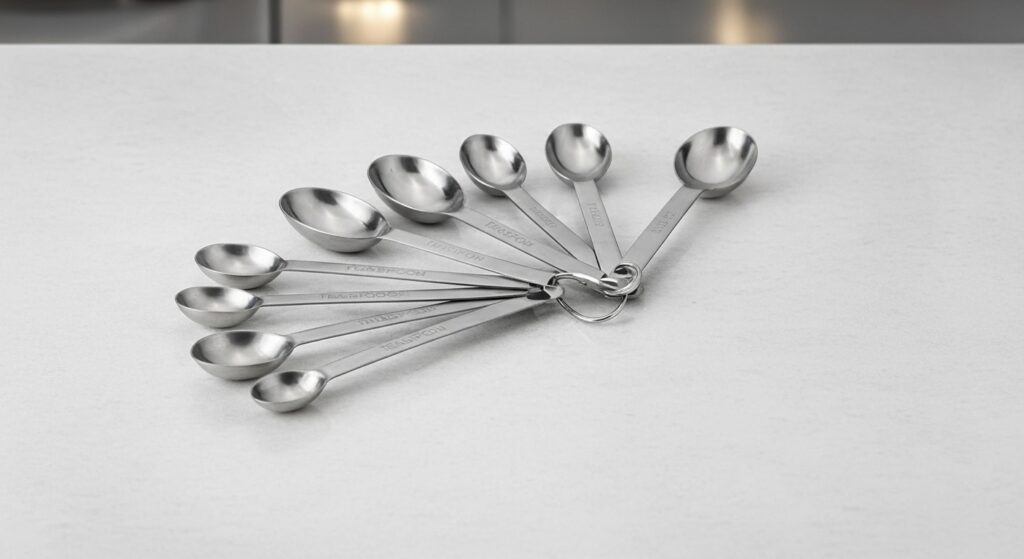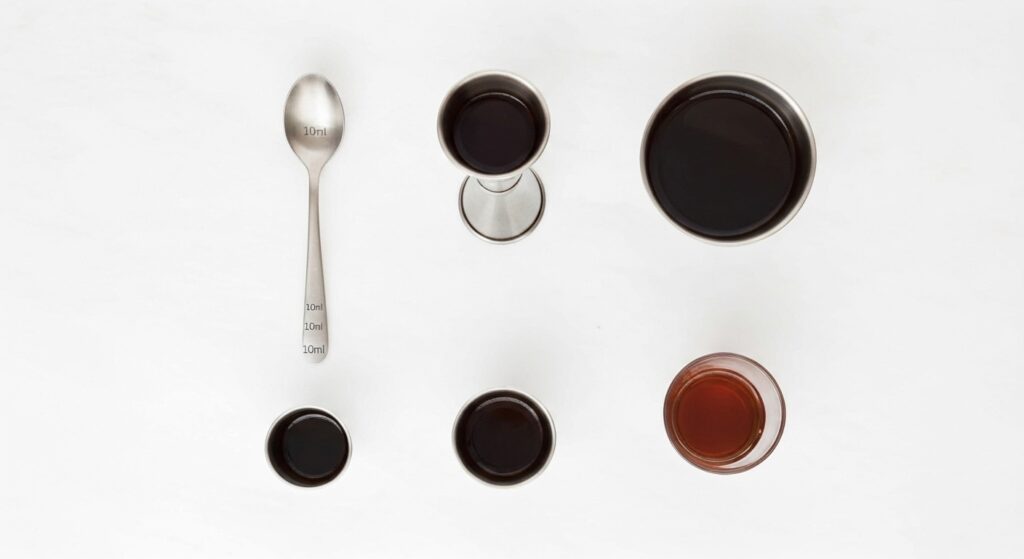What Does 10ml Equal? A Complete 2025 Measurement Guide for Cooking, Medicine, Baking & Everyday Use
Contents
- 1 What Does 10ml Equal? A Complete 2025 Measurement Guide for Cooking, Medicine, Baking & Everyday Use
- 2 What Does 10ml Equal in Common Kitchen Measurements?
- 3 10ml Equals How Many Teaspoons?
- 4 What Does 10ml Equal in Tablespoons?
- 5 What Does 10ml Equal in Fluid Ounces?
- 6 What Does 10ml Equal in Cups?
- 7 What Does 10ml Equal in Grams?
- 8 Where Do You Commonly See 10ml Measurements?
- 9 1. Cooking & Baking
- 10 2. Medicine & Pharmaceuticals
- 11 3. Skincare, Cosmetics & DIY Beauty Products
- 12 4. Essential Oils & Aromatherapy
- 13 5. Beverage Recipes & Cocktail Mixing
- 14 What Does 10ml Look Like in Real Life?
- 15 How to Measure 10ml Without a Measuring Tool
- 16 Method 1: Use Two Standard 5ml Medicine Spoons
- 17 Method 2: Use Two Level Teaspoons
- 18 Method 3: Use a Shot Glass With Markings
- 19 Method 4: Use Drops (Not Exact but Helpful)
- 20 Why Knowing What 10ml Equals Is Important
- 21 Examples of 10ml in Everyday Items
- 22 Quick Reference Chart: What Does 10ml Equal?
- 23 Conclusion
Understanding liquid measurements is a surprisingly common challenge. Whether you’re cooking, mixing skincare products, giving medicine to a child, adjusting a recipe, or learning metric conversions, you might eventually ask: What does 10ml equal?
Although 10 milliliters (ml) sounds like a very small amount, the exact conversion depends on the system you’re using—teaspoons, tablespoons, fluid ounces, cups, or even grams depending on the substance.
This guide explains everything you need to know about what 10ml equals, how to measure it accurately, when it matters most, and how it looks in real life.
What Does 10ml Equal in Common Kitchen Measurements?
When converting 10ml into everyday volume measurements used in cooking and home use, here are the most reliable conversions:
- 10ml = 2 teaspoons (tsp)
- 10ml = 0.67 tablespoons (tbsp) — roughly ⅔ tablespoon
- 10ml = 0.34 US fluid ounces (fl oz)
- 10ml = 0.4 UK fluid ounces
- 10ml = 0.04 US cups
In cooking, medicine, and skincare, 10ml is most commonly measured as 2 teaspoons, because teaspoons are widely available in kitchens and liquid medicine syringes.

10ml Equals How Many Teaspoons?
This is the most commonly searched conversion.
👉 10ml = 2 teaspoons (tsp)
This is based on the international standard measurement:
- 1 teaspoon = 5ml
- Therefore, 10ml = 2 × 5ml = 10ml
This makes teaspoons the easiest and most reliable way to measure 10ml at home when you don’t have a syringe or measuring cup.
If you’re using teaspoons for cooking or medicine, make sure they are proper measuring spoons, not everyday eating spoons. Regular table spoons vary massively in size.

What Does 10ml Equal in Tablespoons?
In tablespoons, the conversion is slightly less intuitive:
- 1 tablespoon (US) = 15ml
- Therefore:
10ml = 10 ÷ 15 = 0.67 tbsp
Which is approximately ⅔ of a tablespoon.
If accuracy matters, it’s better to use teaspoons instead of trying to eyeball two-thirds of a tablespoon.
What Does 10ml Equal in Fluid Ounces?
In US fluid ounces:
- 1 US fl oz = 29.57ml
- Therefore:
10ml = 0.34 fl oz
This measurement is useful when converting recipes, drink measurements, or product quantities written in US imperial units.
In UK fluid ounces:
- 1 UK fl oz = 28.41ml
- So:
10ml = 0.35 fl oz (UK)
The slight difference exists because the U.S. and U.K. use different historical definitions of a fluid ounce.

What Does 10ml Equal in Cups?
Cups are used widely in baking, and it’s helpful to know how tiny 10ml is compared to a cup:
- 1 US cup = 240ml
- So:
10ml = 10 ÷ 240 = 0.04 cups
This is a very small amount—barely visible in a full cup.
If a recipe calls for 10ml, you should never use cups to measure it; teaspoons or syringes are far more accurate.
What Does 10ml Equal in Grams?
Grams measure weight, while milliliters measure volume. They’re only equal when measuring water, because:
- 1ml of water = 1g
So for water:
👉 10ml = 10 grams
But for other liquids, the conversion depends on density:
- Oils: lighter than water
- Syrups & honey: heavier than water
- Alcohol: lighter than water
Here are approximate conversions:
| Substance | 10ml Equals in Grams |
|---|---|
| Water | 10g |
| Olive Oil | ~9g |
| Honey | ~14g |
| Milk | ~10.3g |
| Coconut Oil (melted) | ~9.2g |
| Maple Syrup | ~12.8g |
If you are doing skincare formulation or baking, you should use a digital scale for accuracy.

Where Do You Commonly See 10ml Measurements?
Even though 10ml is small, it plays a major role in several areas of daily life. Here are the most common scenarios where people encounter 10ml:
1. Cooking & Baking
Some recipes—especially European, Asian, or professional pastry recipes—use milliliters instead of teaspoons or tablespoons.
10ml is commonly used for ingredients like:
- Vanilla extract
- Lemon juice
- Soy sauce
- Vinegar
- Oils
- Liquid seasonings
In these cases, 10ml ensures precise flavor balance.
2. Medicine & Pharmaceuticals
Possibly the most important place where 10ml matters is liquid medication dosage.
Doctors or medication labels often instruct:
- Take 10ml twice a day
- Give 10ml to children based on weight
- 10ml dose of cough syrup
Medical accuracy is critical.
Using a kitchen spoon is dangerous because eating spoons are not standardized.
For health-related questions about dosage accuracy, the Mayo Clinic’s medicine measurement guide offers reliable information on using oral syringes and droppers.

3. Skincare, Cosmetics & DIY Beauty Products
In cosmetic formulations, 10ml is frequently used to measure:
- Essential oils
- Carrier oils
- Toners
- Serums
- Hair oils
This is because skincare recipes often deal with small, highly concentrated ingredients.
4. Essential Oils & Aromatherapy
Essential oil blends often mention:
- “Add 10ml of carrier oil.”
- “Use 10ml of diffuser liquid.”
Because essential oils are powerful, precise measurement is crucial for safety.
5. Beverage Recipes & Cocktail Mixing
10ml measurements appear often in mixology because professional bartenders favor precision.
10ml may represent:
- A splash of syrup
- A modifier ingredient
- A small amount of strong liqueur
Cocktail recipes become far more consistent when using milliliters.

What Does 10ml Look Like in Real Life?
Because 10ml is such a small amount, most people without a measuring tool might underestimate or overestimate it. Here’s how it appears visually:
- It fills an average two-thirds of a tablespoon
- It fills two level teaspoons
- It sits as a shallow layer at the bottom of a standard shot glass
- It’s a small sip of water
- It barely coats the bottom of a small sauce dish
If you’ve never seen exactly 10ml, using a syringe or dropper bottle helps create a mental picture of its true size.

How to Measure 10ml Without a Measuring Tool
If you find yourself without a measuring cup or spoon, you can use these improvised methods.
Method 1: Use Two Standard 5ml Medicine Spoons
Almost every home has a medicine spoon or a measuring cap.
Simply fill it twice.
Method 2: Use Two Level Teaspoons
If you’re using proper measuring teaspoons, 2 tsp = 10ml.
Never guess using eating spoons.
Method 3: Use a Shot Glass With Markings
Many shot glasses include 10ml or 15ml lines.
If not, fill to just under halfway of a standard 1 fl oz glass.
Method 4: Use Drops (Not Exact but Helpful)
For water:
- 1ml = 20 standard drops
- So:
10ml = about 200 drops
This method is useful for essential oils and lab use but less reliable in cooking.
Why Knowing What 10ml Equals Is Important
Understanding metric conversions helps prevent:
- Incorrect medication dosages
- Ruined recipes
- Weak or overpowering cocktails
- Unsafe skincare ratios
- Inconsistent product formulations
Even though 10ml is small, accurate measurement matters in many fields.

Examples of 10ml in Everyday Items
To give you a better sense of scale, here are familiar objects that hold around 10ml:
- Single-use soy sauce packets (7–10ml)
- Travel-size serum droppers (10ml)
- Mini perfume sample bottles (10ml)
- Small food coloring bottles (8–10ml)
- Half a tablespoon of cough syrup
- A sip of water (roughly 10ml)
Thinking in terms of objects makes measurement more intuitive.
Quick Reference Chart: What Does 10ml Equal?
| Measurement | Equivalent |
|---|---|
| Teaspoons | 2 tsp |
| Tablespoons | 0.67 tbsp (≈ ⅔ tbsp) |
| US Fluid Ounces | 0.34 fl oz |
| UK Fluid Ounces | 0.35 fl oz |
| Cups | 0.04 cups |
| Grams (water) | 10g |
| Drops (water) | 200 drops |
| Shot Glass | ⅓ of a shot |
This table provides a fast, easy way to remember key conversions.
Conclusion
Now you can confidently answer the question: What does 10ml equal?
In the simplest terms:
- 10ml equals 2 teaspoons,
- ⅔ tablespoon,
- 0.34 fluid ounces,
- 10 grams of water,
- Or a tiny splash in any container.
Even though 10ml is a small amount, it plays a major role in cooking, cocktails, medicine, skincare, and scientific measurement. Knowing how to measure it accurately helps ensure safety, improves recipe consistency, and prevents dosage mistakes.
Whether you’re mixing a recipe, giving medicine, or creating a DIY beauty product, understanding what 10ml equals gives you more control and more accuracy in everything you do.






